By the way, if anyone here would like to continue this general discussion on sidewalks as ways, there’s a separate topic full of insights from around the world:
The nice thing about drawing sidewalk ways by hand, as opposed to automatically, is that you tend to notice near misses, indecision, and other bloopers that you’d otherwise overlook when blanketing a city in more uniform sidewalk ways. Someone looking at OSM data without the benefit of aerial imagery would wrongly conclude that the map is already complete, even though it isn’t upon closer inspection.
When we imported sidewalk ways systematically in San José, California, we initially responded to feedback about the necessity of crossing ways by trying out a tool called Crossify that would come up with candidate crossing geometries based on surrounding sidewalk and road geometries. We’d still review each candidate by hand, but the thinking went that good-guess candidates would streamline that process. This assumes the city builds crosswalks to a consistent standard, so we can tune the algorithm to fit that standard. Unfortunately, we found that our city was just about never consistent about crosswalk placement. I ended up drawing a lot of the crosswalks by hand instead of relying on the generated candidate crossings. But maybe a similar approach would work in a city with a more consistent design process.
Personally, I’m a simpleton who’s pretty satisfied mapping in iD. It comes with some conveniences for mapping pedestrian infrastructure. For example, you can draw a crosswalk across a road without bothering to connect it to the roadway; iD will warn you and offer to add a matching highway=crossing node at the correct location. So if you want to cut down the steps when mapping the sidewalks in a perfect street grid, you could:
- Draw some very long parallel sidewalk ways from one end of the neighborhood to the other.
- Chop up each way at each curb cut.
- Shift-select the short ways spanning the streets and retag them en masse as crosswalks.
- Resolve each of the warnings.
- Spot-check the sidewalks for discontinuities and end runs around trees and utility boxes.
That said, I do miss the parallel ways operation in Potlatch, which I mainly used to separate divided highways that TIGER represented as single ways. (Thankfully, drawing a separate way in that case is uncontroversial.)
Finally, if all this seems too fussy for you, feel free to use the sidewalk:* tags on the roadways and spend time on the things that you prefer to micromap. That’ll leave an opportunity for someone else to come along who prefers to spend their time hand-crafting sidewalk ways.

